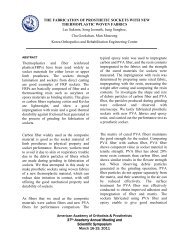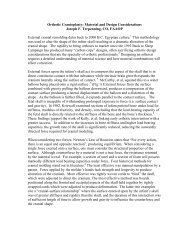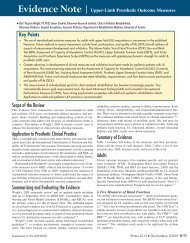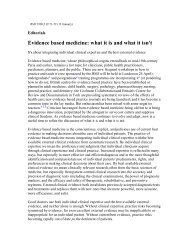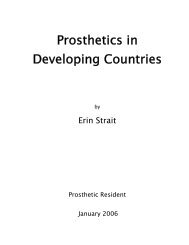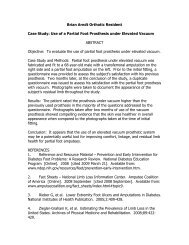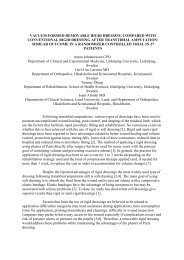The Amputee Mobility Predictor: An Instrument to Assess ...
The Amputee Mobility Predictor: An Instrument to Assess ...
The Amputee Mobility Predictor: An Instrument to Assess ...
Create successful ePaper yourself
Turn your PDF publications into a flip-book with our unique Google optimized e-Paper software.
Score 1: <strong>The</strong> amputee subject cannot or will not stand<br />
without the use of the assistive device or he/she stands independently<br />
and when nudged staggers, grabs at support, or<br />
catches self.<br />
Score 2: <strong>The</strong> amputee subject remains steady with independent<br />
standing free of assistive device.<br />
Item 11: Eyes closed<br />
Task: <strong>The</strong> amputee subject stands with his/her feet 2 <strong>to</strong> 4in<br />
apart. S<strong>to</strong>pwatch ready, the observer asks the amputee <strong>to</strong> close<br />
his/her eyes and maintain standing posture for 30 seconds.<br />
Score 0: <strong>The</strong> amputee subject is unable <strong>to</strong> stand in a steady<br />
positions for 30 seconds without using an assistive device.<br />
Score 1: <strong>The</strong> amputee subject remains steady accomplishing<br />
independent standing without the use of an assistive device.<br />
Item 12: Picking up objects off the floor<br />
Task: <strong>The</strong> amputee subject stands with his/her feet 2 <strong>to</strong> 4in<br />
apart. <strong>The</strong> observer places a pencil (or similar object of same<br />
height) on the floor midline from the amputee subject and 12in<br />
from the <strong>to</strong>e of the amputee subject’s shoe. <strong>The</strong> observer asks<br />
the amputee <strong>to</strong> pick up the object off the floor without moving<br />
his/her feet, knee straight, and (if safely possible) without using<br />
any support.<br />
Score 0: <strong>The</strong> amputee subject cannot pick up the object and<br />
return <strong>to</strong> standing safely.<br />
Score 1: <strong>The</strong> amputee subject performs the task with some<br />
support from an assistive device, chair, or person.<br />
Score 2: <strong>The</strong> amputee subject performs the task without any<br />
help from object or person.<br />
Item 13: Sitting down<br />
Task: <strong>The</strong> examiner asks the amputee subject <strong>to</strong> fold his/her<br />
arms across the chest and sit down in a controlled manner. If<br />
the amputee is unable <strong>to</strong> perform the task or is unsure, the<br />
examiner suggests the amputee subject use his/her arms or an<br />
assistive device.<br />
Score 0: <strong>The</strong> amputee subject misjudges distance <strong>to</strong> the<br />
chair, falls in<strong>to</strong> the chair, or requires contact guarding and is<br />
scored as unsafe.<br />
Score 1: <strong>The</strong> amputee subject chooses for security or necessity<br />
<strong>to</strong> use his/her arms or cannot sit in a smooth and controlled<br />
motion.<br />
Score 2: <strong>The</strong> amputee subject sits in a safe, smooth, and<br />
controlled motion.<br />
To ensure safe ambulation in items 14–20, walking aids are<br />
permitted and encouraged whether or not the amputee wears a<br />
prosthesis. Item 21 compensates for the decision <strong>to</strong> use an<br />
assistive device on the ambulation tasks.<br />
Item 14: Initiation of gait<br />
Task: From a standing posture with or without an assistive<br />
device, as the amputee prefers and the clinician determines <strong>to</strong><br />
be safe, the amputee is asked <strong>to</strong> begin walking.<br />
Score 0: <strong>The</strong> amputee subject shows hesitancy, makes multiple<br />
attempts <strong>to</strong> start, or appears <strong>to</strong> be consciously organizing<br />
in their minds the process of initiating walking beyond the<br />
cognition required for normal ambulation.<br />
Score 1: <strong>The</strong> amputee starts walking with no hesitancy, with<br />
a smooth transition from standing <strong>to</strong> walking.<br />
Item 15: Step length and height<br />
Task: <strong>The</strong> amputee subject walks a measured distance of<br />
12ft (3.66m) twice (up and back) for a <strong>to</strong>tal of 24ft (7.32m).<br />
Four scores are required, ie, 2 scores (a,b) for the left leg and<br />
2 for the right. “Marked deviation” is defined as extreme<br />
substitute movements made <strong>to</strong> permit the foot <strong>to</strong> clear the floor.<br />
a. Swing foot<br />
Score 0: <strong>The</strong> leg does not advance a minimum of 12in. If<br />
ambulating without the prosthesis and with an assistive device,<br />
AMPUTEE MOBILITY PREDICTOR, Gailey<br />
625<br />
the same applies: the swing limbmust advance a minimum of<br />
12in.<br />
Score 1: <strong>The</strong> swing advances a minimum of 12in, whether<br />
the prosthetic limbor the sound limbis being tested.<br />
b. Floor clearance<br />
Score 0: <strong>The</strong> foot does not completely clear floor with step<br />
or deviation. This description includes foot shuffling, sliding,<br />
and marked deviations such as circumduction that require<br />
significant substitution for clearing the floor.<br />
Score 1: <strong>The</strong> foot completely clears floor without marked<br />
deviation<br />
Item 16: Step continuity<br />
Task: As the amputee subject performs the task described in<br />
item 15, the examiner observes the quality of gait. Step continuity<br />
is defined as continuous steps that are devoid of hesitation<br />
(ie, marked differences in step length that require adjustment<br />
for loss of balance between steps), and without difficulty maneuvering<br />
the assistive device sufficient <strong>to</strong> interrupt step continuity.<br />
Score 0: <strong>The</strong> amputee exhibits s<strong>to</strong>pping or discontinuity<br />
between steps that interrupts a smooth continuous gait.<br />
Score 1: <strong>The</strong> amputee subject’s steps appear <strong>to</strong> be continuous.<br />
Item 17: Turning<br />
Task: As the amputee subject completes the first 12ft of<br />
ambulation and turns <strong>to</strong> return <strong>to</strong> the chair, the examiner notes<br />
the quality of the movement.<br />
Score 0: <strong>The</strong> amputee subject is unable <strong>to</strong> turn and therefore<br />
requires intervention such as contact guarding and verbal instructions<br />
in order not <strong>to</strong> fall.<br />
Score 1: <strong>The</strong> amputee subject requires more than 3 steps <strong>to</strong><br />
complete the task but requires no contact or verbal intervention.<br />
Score 2: <strong>The</strong> amputee subject completes the task in 3 or<br />
fewer continuous steps, with or without an assistive aid.<br />
Item 18: Variable cadence<br />
Task: <strong>The</strong> examiner instructs the patient <strong>to</strong> walk a distance<br />
of 12ft fast as safely possible 4 times for a <strong>to</strong>tal of 48ft<br />
(14.63m). Speeds may vary from slow <strong>to</strong> fast and fast <strong>to</strong> slow,<br />
varying cadence. This task may also be completed with an<br />
assistive device although care must be taken that the patient is<br />
not extended beyond his/her capabilities.<br />
Score 0: <strong>The</strong> patient is unable <strong>to</strong> vary cadence in a controlled<br />
manner.<br />
Score 1: <strong>The</strong> patient asymmetrically increase his/her cadence<br />
in a controlled manner so that step length markedly<br />
differs between legs, and/or balance must be re-established<br />
with each step.<br />
Score 2: <strong>The</strong> patient symmetrically increases his/her cadence<br />
in a controlled manner so that step lengths are equal and<br />
balance is maintained.<br />
Item 19: Stepping over obstacle<br />
Task: Place a movable, 4-in high box or hurdle (length,<br />
18–24in) in the walking path. <strong>The</strong> object must be of a design<br />
that will not cause the amputee <strong>to</strong> stumble or fall should he/she<br />
be unable <strong>to</strong> complete the task. <strong>The</strong> amputee is asked <strong>to</strong> step<br />
over the obstacle without interrupting step continuity. This task<br />
may be performed en route <strong>to</strong> or from the stair climbing task.<br />
<strong>The</strong> amputee subject is penalized if he/she attempts <strong>to</strong> circumduct<br />
the obstacle by swinging the prosthetic limb <strong>to</strong> side of the<br />
obstacle.<br />
Score 0: <strong>The</strong> amputee subject cannot step over the box.<br />
Score 1: <strong>The</strong> amputee subject catches his/her foot on the<br />
obstacle, circumducts it, or interrupts stride by s<strong>to</strong>pping in front<br />
of the obstacle <strong>to</strong> prepare physically or mentally <strong>to</strong> clear it.<br />
Arch Phys Med Rehabil Vol 83, May 2002



